Gearbox Gallery’s First Choice in Sanctuary Exhibit
We began our virtual interview on Zoom, and I had Lori’s website up on my computer so we could talk about her work in lieu of being physically in her studio. My first impression was that Lori is a very intuitive artist. She works with an astonishing variety of materials – found objects, pages from old art history books, utilitarian things like staplers, needle and thread, plus graphite, cold wax, and paint to create her art. She works spontaneously through a process of construction, deconstruction, and reconstruction. The finished artwork is imbued with a sense of meaning and what I would simply call “soul.” What follows are excerpts from our long discussion and an edited version of our conversation.
So I thought what we might do is talk through the different sections of your website. The first segment I am interested in is “Sewn Paper,” and the piece I would like to discuss is titled Our Lady of Mending.
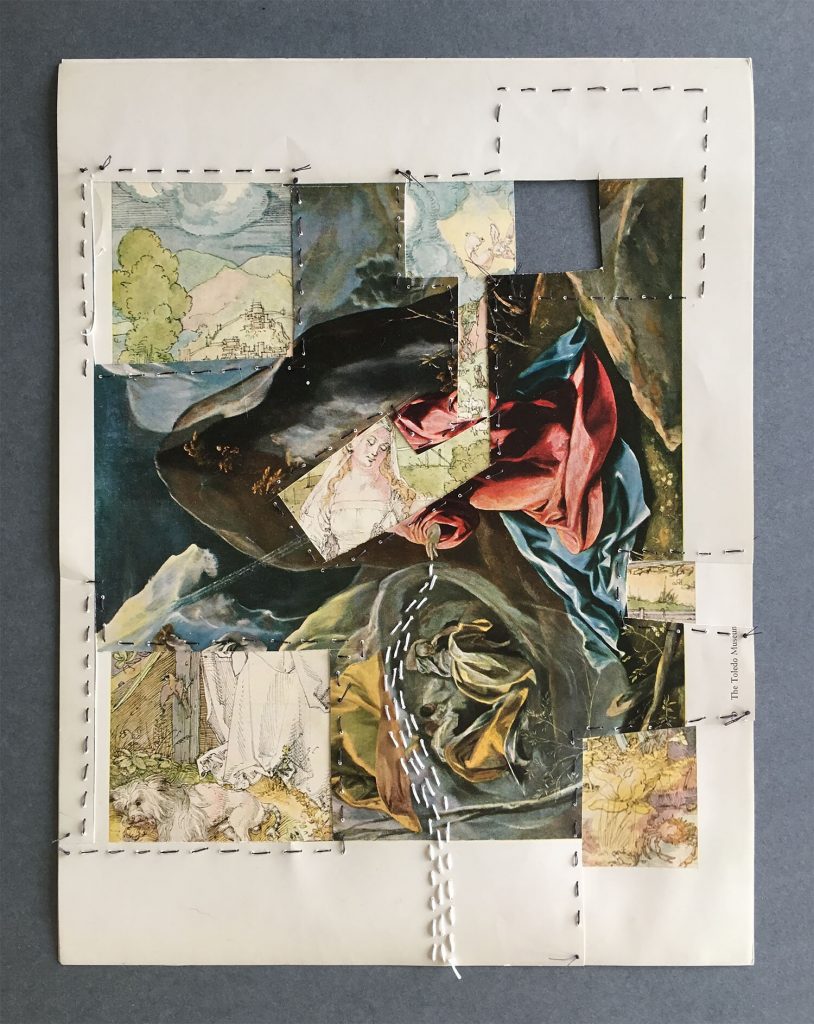
I was given a copy of one of John Canaday’s Metropolitan Seminars in Art books as a challenge to do something with it. Something about this old book spoke to me – art history with the black and white photos and text, combined with my thoughts on what it is like to be a female artist. I began tearing the book apart and working with it as a material. I ended up buying the entire twelve-volume set on eBay, and I’m still working with this set of books. What I do is this messy process. Things get dismantled, and then I put them back together – taking things apart and putting them back together is my way of making things right. That was how sewing and stapling started to come into play, trying to hold these different components together. For this Our Lady of Mending, there were color plate reproductions in an envelope on the inside front cover in each of Canaday’s books, and I cut two of them up and began arranging them, and it just came together.
So I take it that this process is very intuitive.
Oh yeah, I have no idea where I’m going when I start. This piece is a mashup of two prints from Dürer and El Greco. When I cut them up and brought them together, it began to tell a third story that was completely different. So much of Canaday’s writing is a very white, male perspective of art history from the 1950s. Part of what I’m doing is rewriting art history for myself. So, yeah, Our Lady of Mending, she is making it right, at least for me. She is restoring things and sharing her grace.
Do you focus on one series before moving on to another or do you hop around a bit?
Yeah, I tend to jump around a bit. I don’t like to be bored, so I keep moving. I usually am doing a couple of things at once, in different materials. I’ll start something, and I like it, but I might get to a point where I don’t know what to do next, so I go on to another thing – they kind of resolve themselves. I am comfortable to patiently wait until they tell me what to do next. I just keep continuing until they are right and have soul.
Let’s go to the “Stapled Paper” section of your website, and look at the piece that is in the exhibit, Looking for Eden.
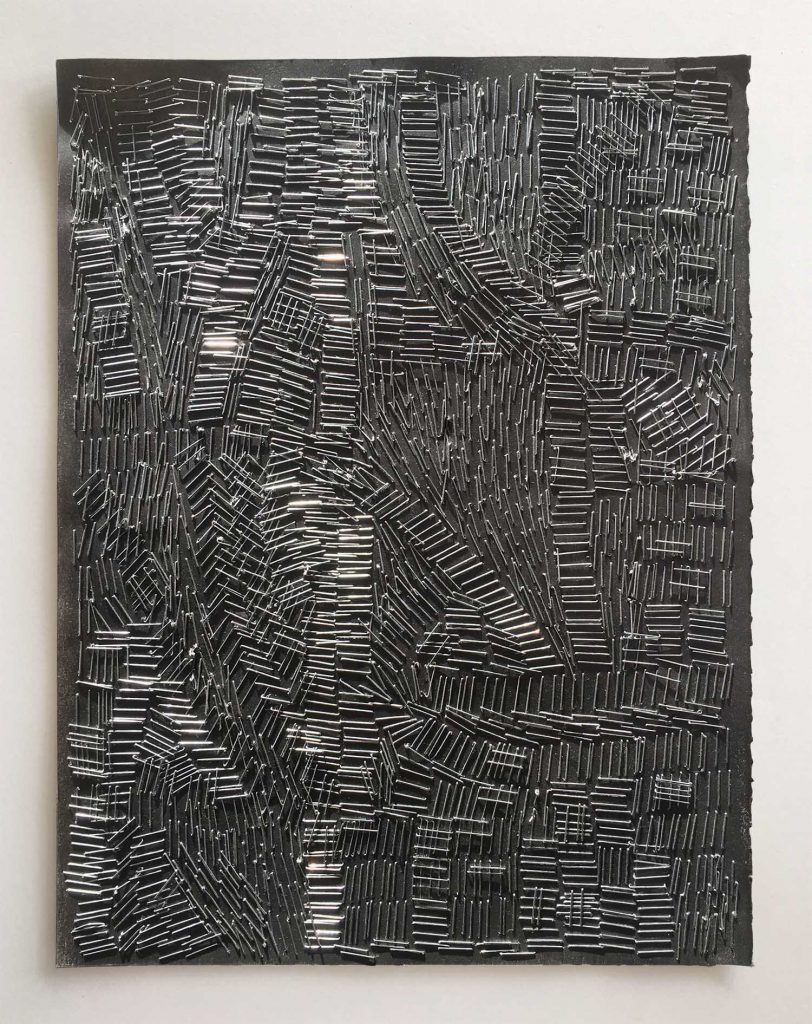
12.5 x 9.5 inches, 2020
It is another of the Canaday book pages. All of these staple pieces are the same size; they’re all the title pages from the books. I love the combination of graphite and cold wax. That’s how I make them black. I rub the whole page with the graphite and get that powder everywhere and then apply the cold wax with a paper towel, and I get this beautiful, dark, satiny black. I love this black, it’s my favorite thing. I began the staple pieces right around the time the pandemic started. I guess it was in February. Anyway, I wondered what the page would look like, covered with staples, and this was the first one I did.
And how did you come up with the title?
Some titles come from things people say in conversation – I’m in an art critique group, and they influence me, but most titles come from what I am thinking and feeling. Stapling this piece was a physical release from the frustration of what was going on at the time. That is where the title came from.
One of the things I really liked about your piece at Gearbox with all the staples was picking it up and feeling its weight.
Yes, the weight of the piece is very seductive, isn’t it? A book page being that heavy is unusual. What is it about that? I wish more people could experience the physicalness of the piece. I thought the stapled paper was an interesting metaphor. It is just a page of a book, and when I initially did it, I wondered if it would fall apart with all the staples, but I was surprised at how resilient the paper was, just like us in a way. I like everything about the book page, its aesthetics, and remembering the history of where it comes from. I also love impaling it with staples. Books tell stories and, in a sense, I think I am telling stories of my own.
OK, let’s go to your “Objects” section on your website. This was the hardest group for me to pick one piece from because I really like all of them, but let’s talk about Venus of Ocean Beach.
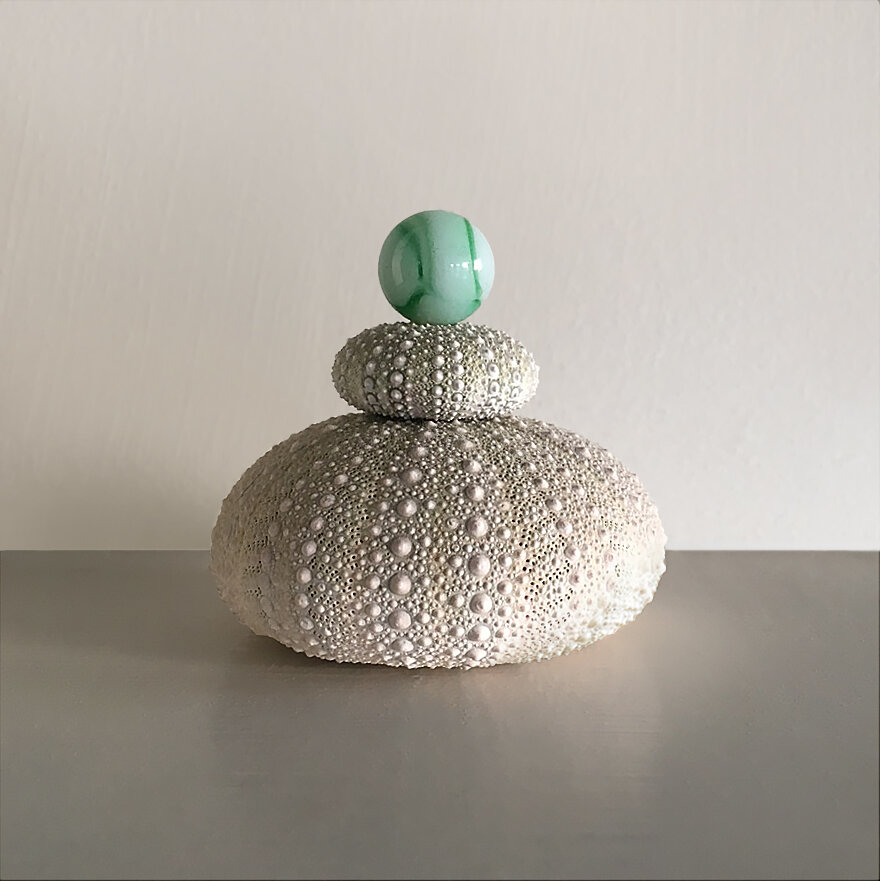
2.5 x 2.5 inches, 2019
All of my materials come from stuff that I have picked up when I walk around my neighborhood and go down to Ocean Beach. I found the sea urchin shells and the marble at the beach. I had stacked them up in my kitchen like that because that’s what I do. I wasn’t even thinking about making art. When I was photographing my artwork for my website, I decided to include my Venus. She is my version of the Venus of Willendorf (upper Palaeolithic statuette, 28,000 to 25,000 BC). I wasn’t intending that I was making art when I stacked her up, and that’s probably the most honest art-making.
Tell me a little bit about Terrorist Jesus.
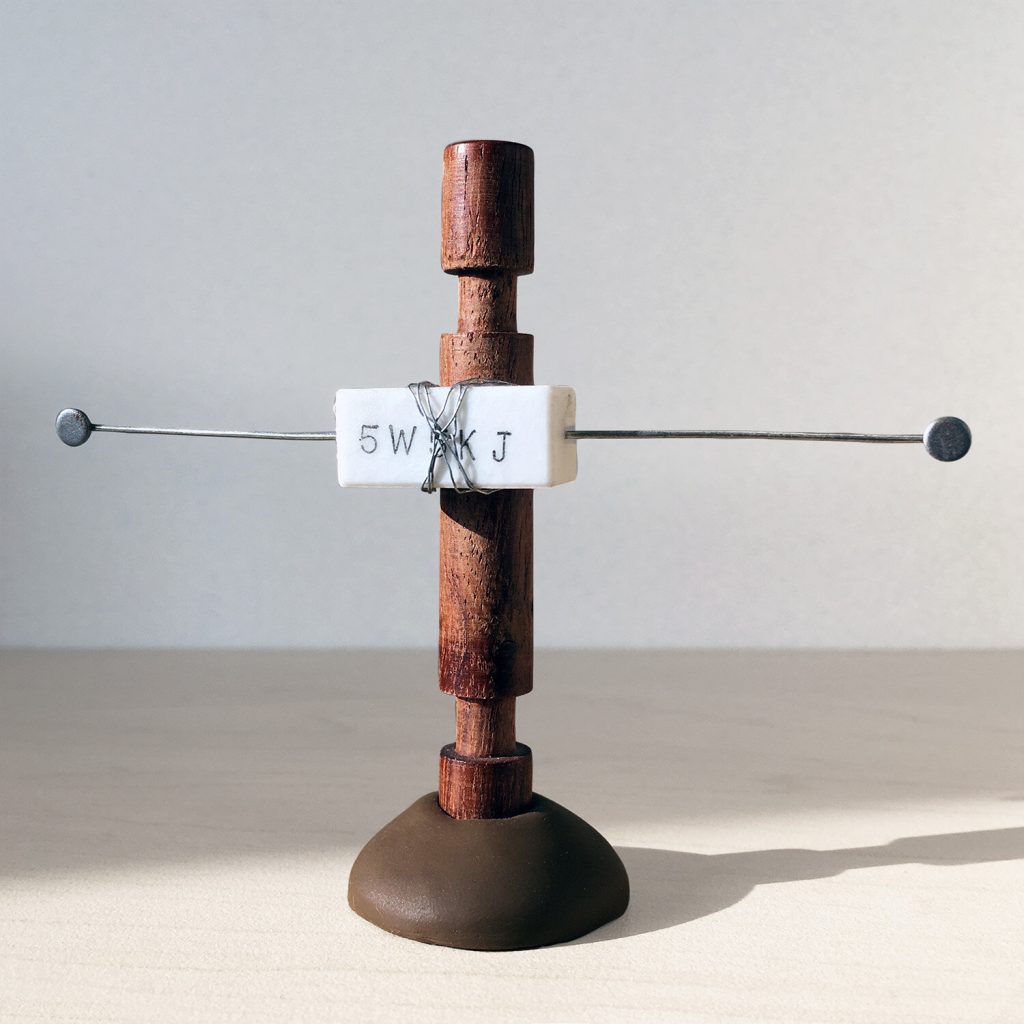
Another story, a good friend gave me some stuff in a brown paper bag to re-use and have fun with – odds-and-ends to think about and mess around with. Among the collection were a wooden peg, little metal circles, and a transistor, with a few other disparate things. I made this figure from the parts in the bag, and as soon as I did it, I realized, oh ****, it’s a crucifix! How in the world did I make a crucifix? Such an iconic thing to make unknowingly. While I struggled in my dismay of what I had made, my sweet husband came up, took one look at it and said it looked like a terrorist with a bomb on his chest. That made it only worse, but that’s how it came to be. Terrorist Jesus, one of my earliest and favorite objects I have made. You don’t always have control over the creative process. Interestingly, we as people have this history of wanting to make these iconic images of heroes, saints, totems, or gods; what is it about us as a community of people that we make these images and puts our hopes and dreams and fears in them…. I think it’s interesting.
Let’s move on to “Book Art” and talk about the No Name (front) and No Name (back).

pencil and spilt wine on book page, each 12.5 x 9.5 inches, 2018
I tore a page out of the art history book, and it was on my table, but the wine got spilled. And I liked how it splattered so I left it there to dry and the next day when I turned it over I saw that the shape coming through on the other side looked like lungs, and so I drew a figure. It’s one page, the front, and the back. I don’t like to frame my art because it turns it into a flat thing behind glass. I think of all my pages as objects, and I prefer to hang them from carpet nails. That’s why I frequently cut triangular holes in the upper corners, so I can hang them on the nails. I think it’s fascinating that a piece can have a front and a back – it sets up a dialogue between the two sides. I should do more of this.
So the next thing up is “Street Art.”

I walk a lot, and there was a corner with this abandoned building that had been boarded up, and I just thought it was beautiful. Someone had put up a large black and white mural of runners – someone else drew graffiti over it, and then it was painted out. I decided I wanted to be part of the visual conversation. I put up my mark, a blown-up photo of an interesting piece of metal I found on the street, on a deer’s body. I really liked the way she looked kind of startled yet curious. (Like she is caught in the headlights.) I thought someone would do something to it, but nothing happened. I drew the speech bubble soliciting a response, but still, no one did anything. Next, I collected trash on the street from the people who lived in the neighborhood and made the flower with it. I like street art because you can’t own it, it’s like a gift that you give and eventually, it’s gone. The whole duration of everything that happened was a couple of years, and every time it got painted out, I’d start again, each time was like another act. From the beginning, I was looking for a visual conversation, and I finally met my match. Someone started pasting all these black and white photos over what I was doing. My goal was to incorporate what they were doing into my own art, and that is how the “Flower Walker” came into being. I loved her. Unfortunately, they spray-painted her out and eventually covered everything over with more photos. It got really ugly, and I decided to stop, and then, the graffiti police sited the building, and they painted everything out blue. I realized I like responding to things. I love having something to bump up against. Things come into my life, and then I start to mess with them. (Or they mess with you!) It’s a game. It’s fun collaborating with someone you don’t even know. I like working in my community. There’s something very poetic about graffiti.
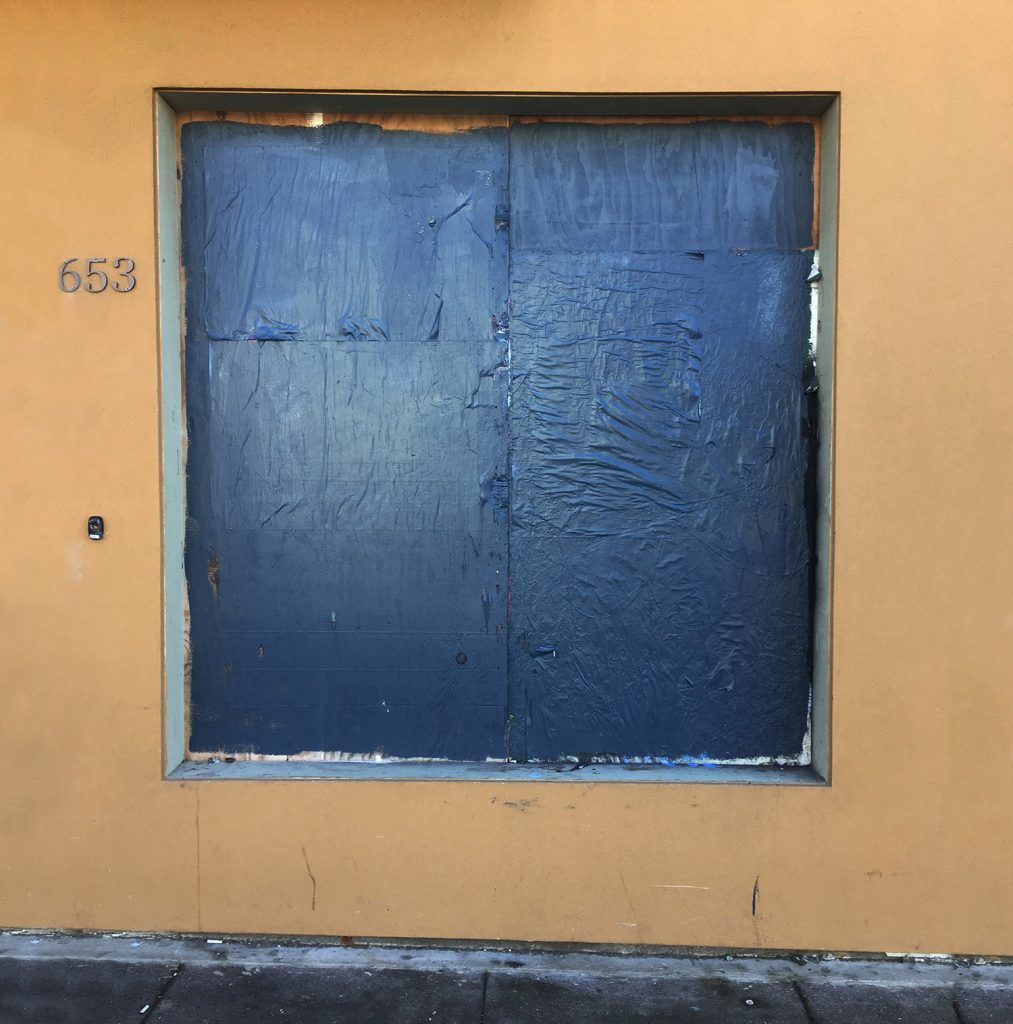
(Our conversation continued in more general terms.)
Art is a very interesting thing. I mean, why do people do it?
I ask myself that all the time.
There’s something about creating and bringing things into existence; that’s pretty phenomenal. I am interested in making art that has a soul, at least for me. I can’t even explain what I’m looking for, but there’s something that seems significant. If I make something and it doesn’t have that, I tear it apart and put it back together again until it has it. And sometimes this has to happen repeatedly before I get it, that patina of history, and story, and evolution. My process forces me to go to places I would never imagine. That’s the journey, and maybe where I find my truth.
